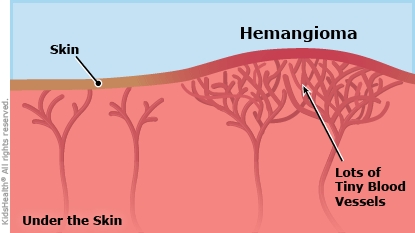Congenital Hemangioma: How to Care for Your Child
A congenital hemangioma (he-man-jee-OH-muh) is a type of birthmark that is fully formed when a baby is born. It's different from the more common infantile hemangiomas, which begin to appear a few days or weeks after a baby is born. A congenital hemangioma is made of tiny blood vessels and is usually red, blue, or purple. Most congenital hemangiomas are on the skin. Rarely, they can be found in the liver. Some go away on their own, while others grow as the child grows. Only some need treatment.


-
If the hemangioma bleeds:
-
With a clean cloth, put firm pressure on the hemangioma for 5 minutes.
-
Check to see if bleeding has stopped.
-
If bleeding hasn't stopped, put firm pressure on the hemangioma for 5 more minutes.
-
Check again to see if bleeding has stopped.
-
If the bleeding has not stopped, keep applying firm pressure and call the doctor.
-
If the hemangioma develops a sore:
-
Wash the area every day and keep it clean.
-
Put petroleum jelly on the hemangioma. If it is in the diaper area or covered by clothing, put a bandage over it. Be sure to change the bandage every day.
-
If the sore develops a crust, it may be helpful to put a clean washcloth moistened with cool water or sterile saline solution on the area for several minutes 2–3 times a day.
-
Most hemangiomas are painless, but they can hurt if a sore develops. If your child has pain, a medicine may help:
-
If your child has an ongoing medical problem (for example, a kidney, liver, or blood problem): Check with your health care provider before giving medicine.
-
For children younger than 3 months: Check with your health care provider before giving medicine.
-
For children 3–6 months: You may give acetaminophen (such as Tylenol® or a store brand).
-
For children older than 6 months: You may give acetaminophen (such as Tylenol® or a store brand) OR ibuprofen (such as Advil®, Motrin®, or a store brand).
-
Don't give aspirin to your child. It has been linked to a rare but serious illness called Reye syndrome.

-
The hemangioma grows very quickly.
-
The hemangioma develops a sore.
-
There is pain, warmth, redness, or swelling around the hemangioma.
-
The hemangioma bleeds and you cannot stop the bleeding by applying firm pressure on it for more than 10–15 minutes.
-
Your child looks pale.

What causes congenital hemangiomas and who gets them? Doctors do not fully understand how congenital hemangiomas form. They may run in families, but no genetic cause has been found.
Will a congenital hemangioma shrink? This depends on the type of congenital hemangioma:
-
rapidly involuting congenital hemangioma (RICH): This type starts to shrink (involute) without treatment right after the baby is born, and is mostly gone by the time a child is 12–24 months old. Sometimes a scar or other change in the skin remains.
-
non-involuting congenital hemangioma (NICH): This type does not shrink. It grows with the baby, staying roughly the same size relative to the baby's body.
-
partially involuting congenital hemangioma (PICH): This type grows with the baby a little bit, then starts to shrink. It does not fully disappear.
When does a hemangioma need to be treated? The health care provider may recommend surgery, laser therapy, or other treatment if the hemangioma:
-
becomes irritated or bleeds a lot
-
gets in the way of eating, breathing, hearing, or seeing
-
causes heart problems because of the amount of blood flowing through it
-
is very big or is upsetting to the parents or child
There are no oral (taken by mouth) medicines that can treat a congenital hemangioma.